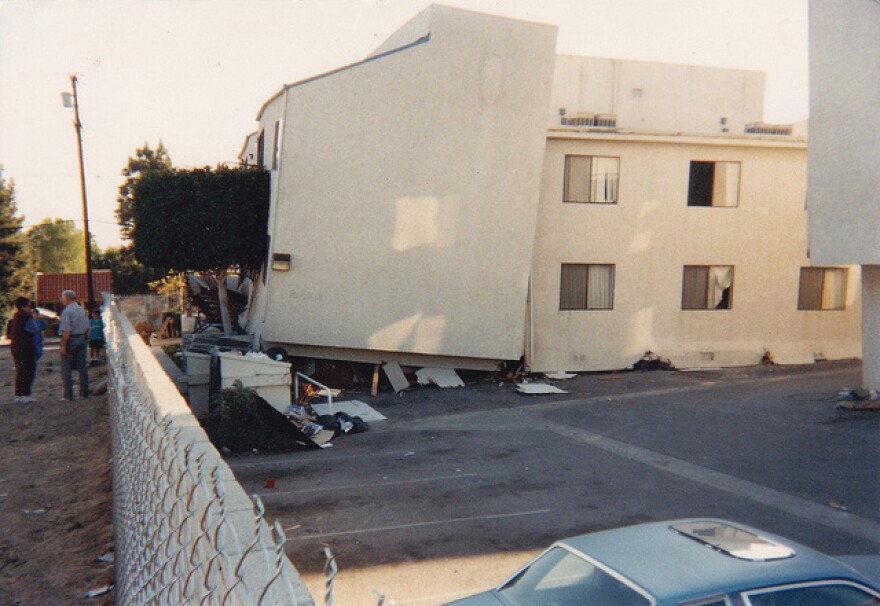With our free press under threat and federal funding for public media gone, your support matters more than ever. Help keep the LAist newsroom strong, become a monthly member or increase your support today during our fall member drive.
This archival content was written, edited, and published prior to LAist's acquisition by its current owner, Southern California Public Radio ("SCPR"). Content, such as language choice and subject matter, in archival articles therefore may not align with SCPR's current editorial standards. To learn more about those standards and why we make this distinction, please click here.
California Could Have Earthquake Early Warning System By 2018

Even though the San Andreas is 'locked, loaded and ready to roll,' California doesn't have an earthquake early warning system. We might, however, have one two years from now, reports the L.A. Times.
Governor Jerry Brown has, until now, staunchly opposed funding an early warning system in the state with state money. For some incomprehensible reason, Brown has believed that any early warning system in the state should be jointly funded by the federal government and private ventures.
But times are changing. The governor is now asking the state legislature to approve $10 million for an early warning system's development and construction. While there are still discrepancies in regard to who will pay for the system's upkeep once it's operational, the mere fact that Brown has announced his support for a state-funded system is a giant leap forward.
"This is going to be a huge boost to the build-out of the system. The infusion of state funding will allow us to surge forward," Doug Given, the U.S. Geological Survey’s earthquake early warning coordinator, told the L.A. Times. "We have the intent of doing limited public rollout by 2018."
Of the $10 million, $6.875 million will be dedicated towards physical equipment and its installation, $2.241 million will be devoted to educating the public on how to respond to the alerts issued by the early warning system, and the remainder will be allocated to staffing and other future costs.
The alerts will be used to sound alarms in places like shopping malls, offices and classrooms. Early warning signals can also be used to halt trains in motion, open elevator doors, and other similar preventative measures. The goal is to give the general public and emergency responders a few seconds of warning before shaking begins (and possibly even a minute).
As Curbed LA points out, earthquake early warning systems already exist in Mexico, Japan, China and Taiwan. The fact that California doesn't have a system, coupled with the system's relatively modest cost (compared to other things we spend public money on), and the fact that developing such a system is technologically very feasible is perplexing.
The proposed system will work, basically, by blanketing the entire state with a network of U.S. Geological Survey earthquake sensors. The sensors instantly signal the location and intensity of any shaking that may occur, and would be tied to a computerized alert system that can determine whether or not to send a broad warning message out to the public. The concept boils down to the fact that radio waves travel much much quicker than seismic waves. In 2014, USGS scientists in Berkeley had almost a minute of warning before shaking from the Napa Earthquake began.
Unfortunately, we're still a few years away from a full public rollout, which would include instantaneous warnings on our cellphones and mobile devices. Developing that capability is very possible, but requires a bit of collaboration with the cell-network providers. And the funding, if granted by the state legislature, means the bones of the system (its sensors) will be built up pretty quickly.
In the meantime, do you have three days of water stored up?
At LAist, we believe in journalism without censorship and the right of a free press to speak truth to those in power. Our hard-hitting watchdog reporting on local government, climate, and the ongoing housing and homelessness crisis is trustworthy, independent and freely accessible to everyone thanks to the support of readers like you.
But the game has changed: Congress voted to eliminate funding for public media across the country. Here at LAist that means a loss of $1.7 million in our budget every year. We want to assure you that despite growing threats to free press and free speech, LAist will remain a voice you know and trust. Speaking frankly, the amount of reader support we receive will help determine how strong of a newsroom we are going forward to cover the important news in our community.
We’re asking you to stand up for independent reporting that will not be silenced. With more individuals like you supporting this public service, we can continue to provide essential coverage for Southern Californians that you can’t find anywhere else. Become a monthly member today to help sustain this mission.
Thank you for your generous support and belief in the value of independent news.

-
The L.A. County Board of Supervisors on Tuesday voted to declare immigration enforcement actions a local emergency.
-
Tens of thousands of workers across Southern California walk out over pay and staffing issues.
-
People in and around recent burn scars should be alert to the risk of debris flows. Typical October weather will be back later this week.
-
Jet Propulsion Laboratory leadership says the cuts amount to 11% of the workforce.
-
The rock legend joins LAist for a lookback on his career — and the next chapter of his music.
-
Yes, it's controversial, but let me explain.







